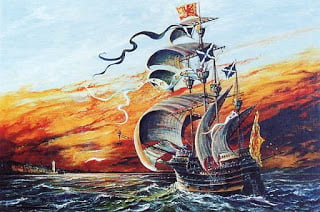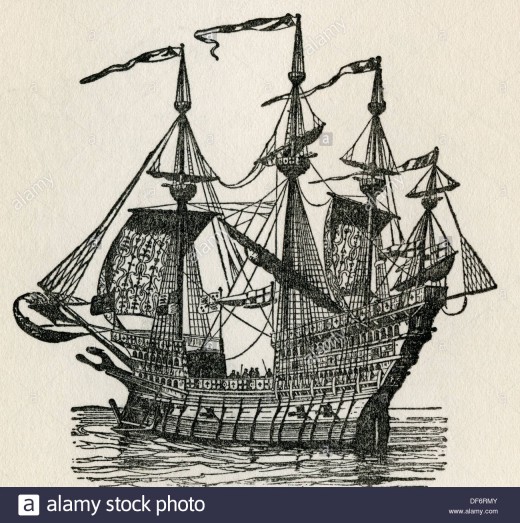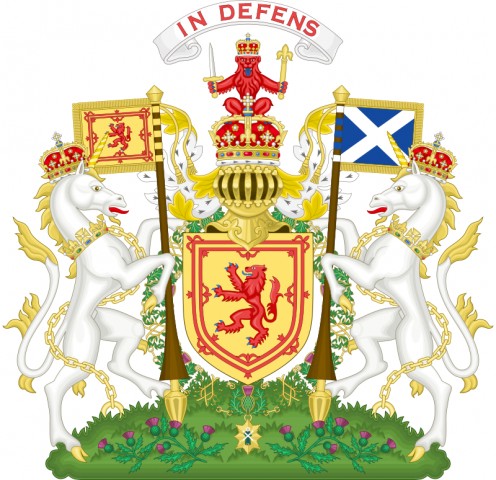
Scotland's Super League Battleship - The Great Michael
For a short time in history, Scotland was a superpower with a state of the art battleship. It did not last long. The nation was allied with a powerful country that won the war against the Papal States and allies. Scotland was victorious, but she lost everything. The historic alliance was to be a tale of monumental bad luck. The nation had been on the winning side of its war but lost the one battle it fought. If ever there was an agony to victory, Scotland paid such a price during the War of the League of Cambrai. The part of the conflict that lasted from 1513 to 1516.
Why Are Some Great Ships Hidden in History?
The Great Michael. A wonderful battleship. The most formidable for its day. Why is it that hardly anyone knows of this galleon? This splendid wooden giant of the sea is obscure. It was state of the art technology back in 1507 when plans were first laid and construction began. This was ordered by Scotland’s successful King James IV. Through honour of a treaty with France, Scotland would go to war. This campaign would see all of the upcoming nation's achievements taken. So many rapid gains lost in a devastating miscalculation. The wonderful ship would be among such losses.
This period of time is often overlooked by many casual history buffs. However, stumbling upon such snippets of information is what makes the offhand reading of such shadowy history a delight. Especially where this great ship is concerned. The construction of the Great Michael was an achievement of envious recognition. Especially from England. In this nation, the twenty-year-old King Henry VIII had come to power a couple of years prior. The young English king wanted a ship of equal worth or better. For he knew the Great Michael was a super league ship of the time. The ship was revolutionary and caused an arms race. All European Monarchs were jealous of the ship. It was no superpower that had built such a vessel. It was Scotland.
All of a sudden, the Great King of Scotland, James IV was a rising star who had been a steadfast and strong leader of his nation. Finally, after previous decades and constant effectiveness of rule, James IV's nation was beginning to show promise. The National influence was the notable development. The improvement and successful economic growth were pursued with shipbuilding to compliment the King's prospering Scotland.
The Scottish king had set a precedent in naval supremacy. The up and coming Stewarts of Scotland had invested wisely in their future. Under King James IV’s rule, the Scots had climbed to the pinnacle. For a brief moment in history, they touched the stars. Scotland would become a naval powerhouse. Their jewel in the crown would be the Great Michael. A ship to behold when launched in 1511. This magnificent galleon had twice the displacement of England’s The Mary Rose. The young and grand English King Henry VIII’s pride and joy. Suddenly, the ship was not good enough. Henry VIII wanted a ship to equal The Great Michael.
For the young English monarch, this was a circumstance that would not do. He brought in all of his shipbuilders and put them to the task of building a battleship to match. This would take three years from the date when the Great Michael was launched. Much would happen between the times of building the Henry Grace à Dieu nicknamed the Great Harry.
The Great Harry of England.

In this time England and Scotland were firm and old enemies. England’s inferior ship The Mary Rose was launched at the same time of 1511. In many ways, it might have been an arms race. The Great Harry was still a few years away from construction.
It is sad and strange how The Great Michael faded into obscurity in such a short space of time. She would be about longer than England's The Mary Rose. The English ship had over thirty-three years of service. The Mary Rose would fight in conflicts with France and Scotland. She may have faded into obscurity too, like The Great Michael.
However, a catastrophic accident made The Mary Rose iconic. The galleon capsized during the Battle of the Solent in 1545. Those last few dreadful moments of the ship’s life would immortalise her. By this point in time, the English king was old. King Henry VIII was watching from the shore when this event happened. It was a moment of dreadful disaster coupled with sensationalism. The King was watching with his entourage. The whole shocking event before their eyes. The disaster that would win huge merit in historical memory. Especially when it was salvaged from the seabed hundreds of years later and put into a museum. So much would be known of the Mary Rose and her life as a galleon in the Royal English Navy. This ship's life and service were magnified to history because of the disaster that befell her.
Perhaps such dreadful things are right to be remembered. However, I can’t help feeling that this great Scottish galleon The Great Michael does not get the recognition she rightly deserves. I think it is simply that her service and fate were not sensational enough. Only a few historians and ship enthusiasts know of her. Yet within the French Navy as The Great Nave of Scotland, this galleon must have seen service.
The Great Michael was sent by King James IV to ally with the French Navy in 1513. The War of the League of Cambrai was in full swing. France was at war with the Papal States and other European powers began to join sides to honour alliances and treaties. Scotland joined with France, Venice and the Duchy of Ferrara.
England joined with the Papal States, Spain, the Holy Roman Empire, the Duchy of Milan and the Swiss Mercenaries. Young King Henry VIII of England went to France and fought with the Holy Roman Empire. Scotland, in support of France, led an ill-fated invasion of England. With the English King absent, the country was under the regency control of Queen Catherine of Aragon.
The Great Michael had been hired by French King Louis XII along with two other Scottish galleons. The Margaret and the James. The battleships were very expensive to run and the loan to an old ally was a sure way of the bankrolling ships from another nation’s purse. The huge ship would never return to Scotland because King James IV was killed at the Battle of Flodden in England. Also, the cream of Scotland’s nobility fell at the furious confrontation. Though Scotland was on the winning side of the war, she was left bankrupt with many of her nobles and king dead.
Scotland’s financial situation had become desperate overnight. The late James IV left his kingdom in the hands of his baby son and wife, Queen Mary Tudor (Elder sister of English King Henry VIII.) She had to be regent with help of the remaining Scottish nobility while the infant king grew up. The Great Michael was sold to the French Navy in the following year of 1514 for a pittance of what the galleon was worth.
The Great Michael was renamed The Great Nave of Scotland and some say she was left in ports and hardly ever put to sea. I doubt this is true and would assume the ship would see service over the decades that would pass. There were rumours that TheGreat Nave of Scotland took part in the Battle of the Solent. This was thirty-one years after being sold to France. This is feasible, but there is no concrete proof that the ship was with the French fleet. She would still have been a formidable vessel thirty years later. I can’t see why such a galleon would not have been used in the French fleet. No one knows what became of her in later years. There are no records to date about The Great Michael's or The Great Nave of Scotland's fate. Scotland’s great galleon of the seas faded from history.
Royal Scots Navy

How could such a thing be?
The War of the League of Cambrai was a bittersweet victory for Scotland.The disastrous battle of Flodden took everything from them. They were on the winning side but lost everything. The King and much of the nation's gentry were gone. A victory that left a winning nation bankrupt.
Scotland's Huge Battleship.
The Galleon that Faded from History
The Great Michael. A ship worthy of any superpower's navy. This colossal battleship of the day belonged to King James IV of Scotland. His navy could boast the finest ship in the world during the year was 1511.



No comments:
Post a Comment